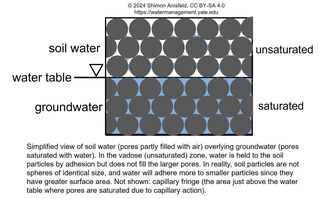Water stocks are stores of water, expressed in units of volume (or sometimes mass). Most of these stocks will be quite familiar to readers and are described very briefly, but we spend more time on soil water and groundwater, which are generally less familiar. For data on the volume of water in various global stocks, see Chapter 2 Table 1(Link opens in new window) of the book.
Oceans: The five oceans (Pacific, Atlantic, Indian, Arctic, Southern) cover 70% of our planet and hold more than 95% of the earth’s water, which is, of course, salt water.
Freshwater lakes: A handful of large lakes—Baikal in Asia, Tanganyika and Malawi in Africa, and the Great Lakes in North America—make up about 70% of global lake freshwater volume, but there are estimated to be over 1.4 million total natural lakes (Messager et al. 2016; this estimate does not include lakes <10 ha in area), and many thousands of human-made reservoirs.
Salt lakes: Salt lakes are saline water bodies that are not connected to the ocean. The Caspian Sea is by far the world’s largest salt lake, but there are many other notable examples, including the Great Salt Lake in Utah, Mono Lake in California, the Dead Sea in the Middle East, and the Aral Sea in central Asia. All of these are terminal lakes, meaning that they have no outlet; water, carrying dissolved salts from rock weathering, flows in from rivers and then evaporates, leaving its salt load in the lake.
Glaciers and ice sheets: Glaciers are large masses of ice formed over time from compression of snowfall over cold land masses, generally high mountains or polar regions. The glaciers in Greenland and Antarctica cover huge areas and are referred to as continental glaciers or ice sheets.
Atmospheric water: Water is found in the atmosphere in two forms: gas (water vapor) and aerosols (suspended droplets of liquid water or particles of ice and snow).

